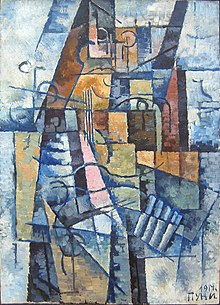Ivan Puni
Ivan Puni | |
|---|---|
 | |
| Born | Ivan Albertovich Puni 20 February 1892 |
| Died | 28 December 1956 (aged 64) Paris, France |

Ivan Albertovich Puni[1] (Russian: Иван Альбертович Пуни; also known as Jean Pougny; 20 February 1892 – 28 December 1956)[2][3][4] was a Russian avant-garde artist (Suprematist, Cubo-Futurist).
Biography[]
Early life[]
Ivan Puni was born in Kuokkala (then Grand Duchy of Finland in the Russian Empire, now Repino in Russia) to a family of Italian origins.[5] He was the grandson of an eminent Italian composer of ballet music, Cesare Pugni. His father, a cellist, insisted that he follow a military career, but Ivan instead decided to take private drawing lessons with Ilya Repin. By 1909, he had his own studio.[1]
Career[]
Puni continued his formal training in Paris in 1910–11 at the Académie Julien and other schools, where he painted in a derivative fauviste style. Upon his return to Russia in 1912, he married fellow artist Kseniya Boguslavskaya, and met, and exhibited with, members of the St Petersburg avant-garde, including Kazimir Malevich and Vladimir Tatlin.[1] He made a second trip to Paris in 1914, returning to St. Petersburg in 1915. At this point, he began painting in a Cubist style reminiscent of Juan Gris. In 1915, Puni, (Aleksandra Ekster, Liubov Popova, Ivan Kliun, Ksenia Boguslavskaya, Olga Rozanova, Nadezhda Udaltsova, Nina Genke and others) formed Supremus, a group of artists dedicated to the promulgation of Suprematism, the abstract art movement founded by Malevich, and first exhibited at the 0,10 Exhibition. Malevich and Puni co-authored the Suprematist Manifesto, published in 1916, which proclaimed a new, abstract art for a new historical era.
Puni also organized the exhibitions and 0.10, both held in St Petersburg in 1915, in which Malevich, Tatlin, Popova and others participated, and to which Puni contributed constructions, readymades, and paintings.[1] In 1915-1916 Puni, together with other Suprematist artists, worked at Verbovka Village Folk Centre. In 1919, he taught at the Vitebsk Art School under Marc Chagall.[1]
Years of Exile[]
Puni and his wife, Kseniya Boguslavskaya, emigrated from Russia in 1919, first to Finland, then in 1920 to Berlin,[1] where the first exhibition consisting entirely of his work was held at the Galerie der Sturm. While in Berlin, Puni also designed costumes and sets for theatrical productions, and published a book criticising Suprematism.[1]
Puni and Boguslavskaya relocated to Paris in 1924,[1] where his style changed once again to a variant of Impressionism. In France, he signed his work as "Jean Pougny", in an effort to distance his new art practice from his previous one in Russia. In 1946, Puni/Pougny became a French citizen. He died in Paris in 1956.
See also[]
References[]
- ^ Jump up to: a b c d e f g h Sarabianov, Andrei D. "Ivan Albertovich Puni". Encyclopedia Brittanica. Retrieved 6 June 2020.
- ^ ru: Русская живопись // Пуни Иван Альбертович (1892—1956)
- ^ ru: Пуни Иван Альбертович (1892—1956)
- ^ ru: ПУНИ Иван (Жан) Альбертович / Pougny Jean
- ^ "Kuokkala". Archived from the original on October 26, 2009. Retrieved 2006-12-11.CS1 maint: bot: original URL status unknown (link)
External links[]
- pougny-jean-ivan-puni-called Ivan Puni in American public collections, on the French Sculpture Census website

- 1894 births
- 1956 deaths
- Russian avant-garde
- Russian artists
- Russian people of Italian descent
- Alumni of the Académie Julian
- Naturalized citizens of France
- Russian designers
- White Russian emigrants to France
- Suprematism (art movement)
- Emigrants from the Russian Empire to France
